As oil drops, Oman's property market shivers
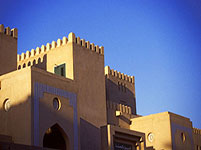 The opening of Oman’s real estate market to foreigners began in 2002, as part of the “Vision 2020” plan, which aimed to diversify Oman’s economic base and reduce its dependence on oil revenues. In December 2002, GCC nationals gained the right to own real estate for residential or investment purposes. In February 2006 other nationalities were also given the right to own real estate, but only in Integrated Tourism Complex (ITC) developments.
The opening of Oman’s real estate market to foreigners began in 2002, as part of the “Vision 2020” plan, which aimed to diversify Oman’s economic base and reduce its dependence on oil revenues. In December 2002, GCC nationals gained the right to own real estate for residential or investment purposes. In February 2006 other nationalities were also given the right to own real estate, but only in Integrated Tourism Complex (ITC) developments.
By buying property, expatriate owners automatically get residency rights for themselves and their immediate families.
Growing expat numbers fuelled a real estate boom. The expat population rose by 12.6% per annum during the period 2004-2014, and by 2014 there were 1,732,188 expats in Oman, according to the National Centre for Statistics and Information
The major ITCs such as Al Mouj Muscat (formerly The Wave) and Muscat Hills Golf and Country Club have led the country´s housing market in terms of growth and value. These ITC developments have continuously attracted owners and tenants, with "virtually zero" vacancies and high rents, according to Savills Oman.
ITC prices fell during 2009, but these properties remain in demand due to their superior design, setting and facilities. In Al Mouj Muscat and Muscat Hills, resale values of apartments rose by around 6% in Q4 2015 from the previous year, according to Savills Oman.
AVERAGE SALES PRICE IN THE SECONDARY MARKET FOR ITC PROPERTIES |
||||
| Property Type | Price per sq. m. (OMR) | Price per sq. m. (USD) | Price per apartment (OMR) | Price per apartment (USD) |
| Apartment | ||||
| 1 Bedroom | 1,019 | 2,650 | 96,800 | 251,755 |
| 2 Bedroom | 1,137 | 2,957 | 159,000 | 413,523 |
| 3 Bedroom | 1,042 | 2,710 | 230,000 | 598,178 |
| Villa | ||||
| 3-4 Bedroom | 1,085 | 2,822 | 352,000 | 915,472 |
| 4-5 Bedroom | 1,190 | 3,095 | 530,000 | 1,378,410 |
| 5+ Bedroom | 1,333 | 3,467 | 610,000 | 1,586,472 |
| Source: Savills Oman | ||||
Recent Integrated Tourism Complex (ITC) Developments in Oman:
- Juman One – Al Mouj launched this as their primary premium marina front apartment complex. It consists of luxury apartments offered at from OMR 120,000 (US$ 312,093) for one-bedroom units, to OMR 806,000 (US$ 2,096,223) for five-bedroom penthouses.
- The Links – 270 luxury apartments located at Muscat Hills, still under construction with completion targeted in 2017. The average sales price is OMR 810 (US$ 2,107) per square metre (sq. m.).
Aside from the continuous interest in the ITCs, there has been significant ´off plan´ sales of new apartment developments in the Muscat neighborhood. Demand has been driven by younger Omanis, who buy 75% of all central area developments, according to Savills Oman. These well-educated and savvy individuals are eager to create their own investment portfolios, buying units they intend to lease out upon completion.
Aside from younger Omani buyers and Gulf Cooperation Council (GCC) nationals, other groups such as Syrians, Iranians also buy houses in the Sultanate. According to Cluttons, their typical budgets range from OMR 130,000 (US$ 338,101) to OMR 150,000 (US$ 390,117).
The value of property sales rose by 2.3% to OMR 1,022.6 million (US$ 2.7 billion) from January to October 2015, compared to the same period last year, according to the National Centre for Statistics and Information (NCSI).
The plan: reduce expat numbers, boost local employment
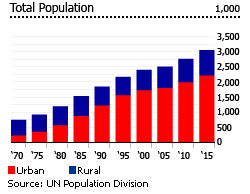
Foreigners account for almost 90% of all workers in Oman´s private sector, according to the Manpower Ministry.
Oman´s population is 57% native Omanis and 43% expatriates, far from the 75:25 ratio of Omanis and expats in 2004. Oman’s population is young, with a median age of 24.9 years in 2014. Oman´s total population was 3.99 million in 2014, and has been growing at an annual average rate of 5.2% since 2004.
In February 2014, the Omani government announced its intention to cut its expatriate population to 33% of total population. Oman thus joins the growing list of GCC countries planning reduce expat workers, to bolster local employment.
However, no specific measures were announced by Minister of Manpower Sheikh Abdullah bin Nasser Al Bakri, suggesting that the government expects a natural drop, aided by firmer enforcement of the Labour Law.
Rents to remain stable
Rents in Oman skyrocketed in 2008-2009, especially in Muscat and other high demand areas. After rising 21.4% in 2008, rents rose 16% in 2009. But by 2010, rental rates were dropping because of a huge new supply of residential rental properties, much of it of lamentably poor design and quality.
A few years back, Cluttons forecast that a two-tier market would develop. Properties well-matched to tenant desires in terms of quality and design would have high occupancy rates and relatively stable rental values. Poorly built properties would have declining rents, and be mostly uninhabited.
This is largely what has happened. There has been a continuous drop in demand and declining rental levels for older-style properties in the established central areas. The take-up of these properties has been very slow, due to a surge of new modern apartments with amenities and finish meeting international standards.
Rents have however remained stable in most areas. There have even been slight rises in areas benefiting from the improved accessibility brought by the Expressway and new interchanges.
It was only in Q3 2015 that rents across Muscat fell by 4.7%, following five consecutive quarters of stability, according to Cluttons. The drop was headed by the villa market, with monthly rents falling by around 5.9%. Rents in Azaiba/Ghubrah North (-13.9%) slipped significantly, due to an increasing amount of poorer quality stock, weakening rents.
Monthly rents for two-bedroom apartments In central areas (excluding ITC´s) in Q4 2015 range from OMR 300 (US$ 780) to OMR 750 (US$ 1,951), according to Savills Oman, slightly lower than rents during the second half of 2014. Rents for 4+ bed villas were around OMR 475 (US$ 1,235) to OMR 1,900 (US$ 4,941).
Rents in Al Mouj Muscat (formerly known as The Wave) range from OMR 850 (US$ 2,211) to OMR 1,900 (US$ 4,941) depending on the housing type, while rents in Muscat Hills range from OMR 750 (US$ 1,951) to OMR 1,900 (US$ 4,941).
Cluttons notes that demand remains "centred on what are perceived to be high quality, well managed properties". The firm predicts that rents will remain "fairly stable" over the next two quarters.
New amendments to the tenancy law
Rental laws in Oman were last changed by the amended Royal Degree (107/2010). New rules included:
- The rule that landlords may only increase rent every 3 years was modified. The parties can now agree otherwise.
- The maximum rent increase of 7% of the annual rent stipulated in the lease contract has been removed.
- The earliest period that a landlord an terminate a lease for commercial property was trimmed down to 5 years, from the previous 7, and from 4 to 3 years, in the case of residential properties.
- Landlords can now retrieve expenses incurred in lawsuits related to eviction notices served to non-paying tenants, due to a new legal procedure.
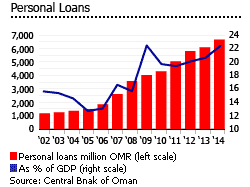
Residential housing loans stand at close to 7% of the banking sector´s total credit portfolio, well within the 15% ceiling stipulated in June 2014, according to the CBO. Before 2006, only two banks were allowed to make housing loans, the government-owned Oman Housing Bank, and the privately-owned Alliance Housing Bank. In 2006, commercial banks generally were permitted to offer housing mortgages. Their lending cap was progressively raised from 5% of total loan portfolio, to the present 15%.
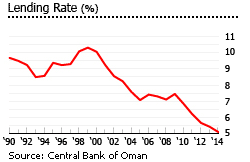
The Central Bank of Oman (CBO) has enforced a 6% interest ceiling on personal loan interest rates since October 2013. In December 2014 the average lending rate was 5.08%.
In 2015, Oman´s inflation is expected to be around 0.41%, according to the IMF, partly due to low global commodity prices. In 2014 average inflation was only 1%.
Oil sector still dominates; economic diversification continues
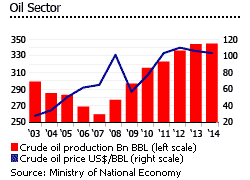
Oman´s diversification plan “Vision 2020” has been quite effective. Oil remains Oman´s top revenue generator, although the country´s 4.6% economic growth in 2014 was characterized by a 2.4% decline in the petroleum sector, offset by 10.1% growth in the non-hydrocarbon sector.
Petroleum activities´ contribution to Oman´s total GDP in 2014 did not exceed the 50% mark, at around 47.2%, down from 50.6% of nominal GDP in 2013, and 52.3% in 2012. The service sector contributed around 40.7% of GDP in 2014, a sharp rise of 13.1% from 37.7% in 2013. Non-petroleum industrial activities were around 18.1% of GDP.
The decline of the petroleum sector was largely due to the drop of crude oil prices in 2014 from US$ 108 at the start of the year, to US$55 at the end. However since then, crude oil prices have declined even further, and are now around US$ 36.5 per barrel.
Oman´s 8th Five-Year Development Plan (2011-2015) targets "development of Small and Medium Enterprises (SME), developing the financial sector, financing the private sector, improving investment climate and developing infrastructure". These efforts are expected to be intensified in the 9th Five-Year Development Plan (2016-2020). The government is also developing the Duqm Special Economic Zone (SEZ), a commercial and tourist zone expected to become an industrial centre, and attract foreign investments.
The 9th Five-Year Plan
The Omani government is still in the process of completing its 9th Five-Year Plan (2016-2020), but it is certain that the plan will focus on economic diversification, welfare and social benefits enhancement, and boosting the private sector. It will support "the five prime sectors of manufacturing, logistics, tourism, fisheries, and minerals,” according to H. E. Dr. Ali Al-Sunaidy, Minister of Commerce and Industry.
One feature of the plan is new public-private partnerships (PPPs), including:
- The Mandinat Al Ifran project
- Port Khasab
- Port Sultan Qaboos
- Soth Batinah Logistics Area
The 9th Five-Year Plan also includes projects carried forward from the current Five-Year Plan.
Housing has been given less in the 2015 budget, with OMR 2.3 billion (US$ 5.98 billion), down from OMR 2.8 billion (US$ 7.28 billion) in 2014.
Oman had 551,058 housing units in 2010, 27.9% up on 2003. Arabic houses comprised 31.2% of the total housing stock; villas, 28.6%; apartments, 20.9%; rural houses, 3.2%; and improvised housing units, 2.4%.